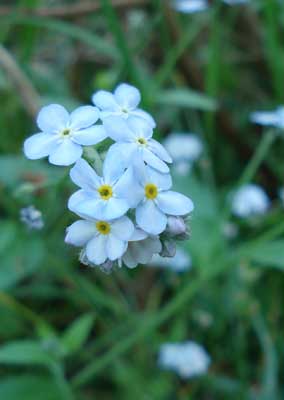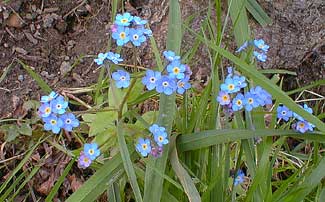
Wild Forget-me-Nots
"Blossomed the lovely stars,
the forget-me-nots of the angels."
-Henry Wadsworth Longfellow
(1807-1882)
(1807-1882)
Forget-me-nots (Myosotis salvatica) are among the most persisting volunteers to errupt in Northwest gardens. Some people fight them as weeds, but really they're so pleasing & of such unobtrusive size, crowding out nothing else, it should be no problem to embrace them as unplanned delights, even if they do spread like, well, weeds.
 Forget-me-Not is actually a tender biennial but self-seeds so reliably it might as well be regarded as perennial, since it will recurr perennially whether you want it to or not.
Forget-me-Not is actually a tender biennial but self-seeds so reliably it might as well be regarded as perennial, since it will recurr perennially whether you want it to or not. There are a number of cultivated forms including pink & white, but none improve on the wild blue, & purchasing them potted or as seeds seems silly when they're bound to appear in the garden on their own.
The April photo at right shows the first patch of the season, leaping out of grass. By May (photo at top) they're all over the place. They usually vanish during the heat of summer though it's no great surprise if they reappear randomly in unpredictable locations until deep into autumn. If intentionally cultivated it will bunch up to a soft clump of ten or so inches high, but as a randomly-appearing volunteer usually provides a very tiny spot of color.
The larger forget-me-nots encountered growing in extremely boggy areas or even in shallow water are M. scorpiodes or Water Forget-Me-Not, plus a diminuative water's-edge version is M. laxa, the Tufted Water Forget-me-Not. On hiking expeditions one also encounters the diminuative Hackelia micrantha, the "False Forget-me-Nots" or "Stickseed," called the latter because the seeds stick to hikers' pantlegs & dogs' fur.
But the volunteer most seen in yards is M. salvatica ( synonymous with M. alpestris & M. oblongata). This is the common Woodland or Garden Forget-Me-Not today regarded as practically a native wildflower since it will be seen along even the most out-of-the-way mountain trails. It's Eurasian in origin, however, though by now thoroughy naturalized in all temperate areas of North America.
Forget-me-nots are of the borage family, & identical tiny blue blossoms occur on larger perennials of this family. For example, we are graced with long-lasting forget-me-not blooms upon Brunnera macrophylla .
The Scottish poet William McGonagall (1825?-1902) rhymed a romantic medieval legend that is is supposed to explain the origin of the flower's common name, & I cannot resist quoting the entirety of his poem "Forget Me Not":
A gallant knight & his betroth'd bride,
Were walking one day by a river side,
They talk'd of love, & they talk'd of war,
And how very foolish lovers are.
At length the bride to the knight did say,
'There have been many young ladies led astray
By believing in all their lovers said,
And you are false to me I am afraid.'
'No, Ellen, I was never false to thee,
I never gave thee cause to doubt me;
I have always lov'd thee & do still,
And no other woman your place shall fill.'
'Dear Edwin, it may be true, but I am in doubt,
But there's some beautiful flowers here about,
Growing on the other side of the river,
But how to get one, I cannot discover.'
'Dear Ellen, they seem beautiful indeed,
But of them, dear, take no heed;
Because they are on the other side,
Besides, the river is deep & wide.'
'Dear Edwin, as I doubt your love to be untrue,
I ask one favour now from you:
Go! fetch me a flower from across the river,
Which will prove you love me more than ever.'
'Dear Ellen! I will try & fetch you a flower
If it lies within my power
To prove that I am true to you,
And what more can your Edwin do?'
So he leap'd into the river wide,
And swam across to the other side,
To fetch a flower for his young bride,
Who watched him eagerly on the other side.
So he pluck'd a flower right merrily
Which seemed to fill his heart with glee,
That it would please his lovely bride;
But, alas! he never got to the other side.
For when he tried to swim across,
All power of his body he did loss,
But before he sank in the river wide,
He flung the flowers to his lovely bride.
And he cried, 'Oh, heaven! hard is my lot,
My dearest Ellen! Forget me not:
For I was ever true to you,
My dearest Ellen! I bid thee adieu!'
Then she wrung her hands in wild despair,
Until her cries did rend the air;
And she cried, 'Edwin, dear, hard is out lot,
But I'll name this flower Forget-me-not.
'And I'll remember thee while I live,
And to no other man my hand I'll give,
And I will place my affection on this little flower,
And it will solace me in a lonely hour.'
In this concluding segment I would like, if I may, to convey a darkly satiric legend as to how this flower obtained the genus name Myosotis, which means "mouse-eared."
This name would seem to have been more apropos of certain violets with mouse-eared blossoms. Some, seeking a reason for this name, have strained to see a mouse's ear in the lightly pubsescent leaf. But the inspiration for the name is really not known, though I had an idea, one which requires some background information:
Masons like to tell the pretty story (unfortunately unsupported by historical scholarship) that the forget-me-not was used as a symbol of masonic resistance to nazism. This legend has attached to it the unlikely premise that nazi death camps permitted inmates to keep their personal jewelry. Upon that poorly thought out supposition, so it is told, masons were able to recognize one another in the camps, by a small blue flower-pin worn in their lapels (the nazis apparently also let imprisoned masons wear smart jackets with lapels).
Certainly such pins existed during the war, & are today worn to commemorate the legend. I don't want to fault masons for inventing & wanting to believe in the meaning & purpose of this pin, which may first have been used as an emblem of masonic friendship in the 1920s. But it is also documented that certain fund-raising activities by the nazis themselves coopted the blue-flower lapel pin, & in 1938, youths wore these as evidence that they had contributed to a funding effort for rearmament.
The forget-me-not lapel pin had become a symbol of nazi affiliation, therefore even if it had once meant something finer to masons, it certainly did not indicate resistance to nazism, nor would any member of any group unsupportive of the nazis reveal themselves by pins that commemorated nazi fundraising. The pins that were used by the nazis, & by the masons, were exactly the same pins, made by a factory at Selb near the town of Bayreuth.
The actual history, opposed to the legend, has been used by people paranoid about Masons in order to malign masonry & tie it to Hitler's own fascination for the occult. I am sorry to see it taken that far. I do perceive the legend as invented & embraced by German Masons to evade or paliate guilt, but I also believe many masons suffered under nazism. Only after the war did the forget-me-not begin to commemorate masons who resisted or who were killed by nazis. And those who actually did so do deserve commemoration.
So I prefer to build on the brave myth of masonic resistance, instead of the less bold implications the scholarship has revealed about those pins. And I suddenly fancied that there may once have been an Order of the Mouse-onic Brotherhood, in resistance against totalitarian cats, which explains the flower's genus name!
No doubt my fondness for Beasts-in-Britches children's tales, like those of Thornton Burgess, inspired this vision of mice forced underground by persecution. It was a time when those of the Mouse-onic Order recognized one another by wee blue flowers that served them as appropriate-sized boutonieres!